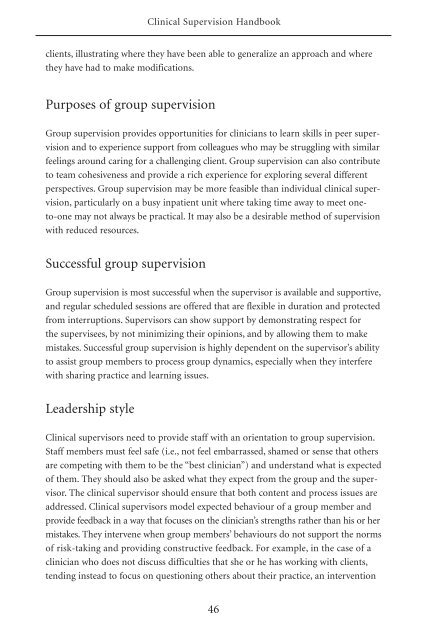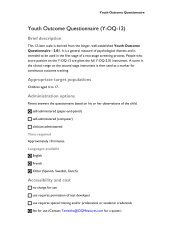Clinical Supervision Handbook - CAMH Knowledge Exchange ...
Clinical Supervision Handbook - CAMH Knowledge Exchange ...
Clinical Supervision Handbook - CAMH Knowledge Exchange ...
Create successful ePaper yourself
Turn your PDF publications into a flip-book with our unique Google optimized e-Paper software.
clients, illustrating where they have been able to generalize an approach and where<br />
they have had to make modifications.<br />
Purposes of group supervision<br />
Group supervision provides opportunities for clinicians to learn skills in peer supervision<br />
and to experience support from colleagues who may be struggling with similar<br />
feelings around caring for a challenging client. Group supervision can also contribute<br />
to team cohesiveness and provide a rich experience for exploring several different<br />
perspectives. Group supervision may be more feasible than individual clinical supervision,<br />
particularly on a busy inpatient unit where taking time away to meet oneto-one<br />
may not always be practical. It may also be a desirable method of supervision<br />
with reduced resources.<br />
Successful group supervision<br />
Group supervision is most successful when the supervisor is available and supportive,<br />
and regular scheduled sessions are offered that are flexible in duration and protected<br />
from interruptions. Supervisors can show support by demonstrating respect for<br />
the supervisees, by not minimizing their opinions, and by allowing them to make<br />
mistakes. Successful group supervision is highly dependent on the supervisor’s ability<br />
to assist group members to process group dynamics, especially when they interfere<br />
with sharing practice and learning issues.<br />
Leadership style<br />
<strong>Clinical</strong> <strong>Supervision</strong> <strong>Handbook</strong><br />
<strong>Clinical</strong> supervisors need to provide staff with an orientation to group supervision.<br />
Staff members must feel safe (i.e., not feel embarrassed, shamed or sense that others<br />
are competing with them to be the “best clinician”) and understand what is expected<br />
of them. They should also be asked what they expect from the group and the supervisor.<br />
The clinical supervisor should ensure that both content and process issues are<br />
addressed. <strong>Clinical</strong> supervisors model expected behaviour of a group member and<br />
provide feedback in a way that focuses on the clinician’s strengths rather than his or her<br />
mistakes. They intervene when group members’ behaviours do not support the norms<br />
of risk-taking and providing constructive feedback. For example, in the case of a<br />
clinician who does not discuss difficulties that she or he has working with clients,<br />
tending instead to focus on questioning others about their practice, an intervention<br />
46

















